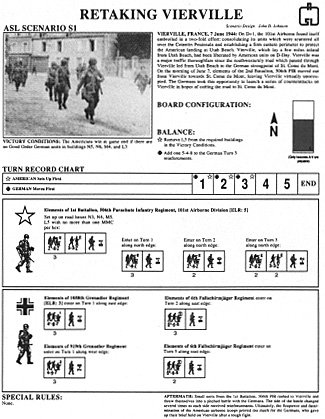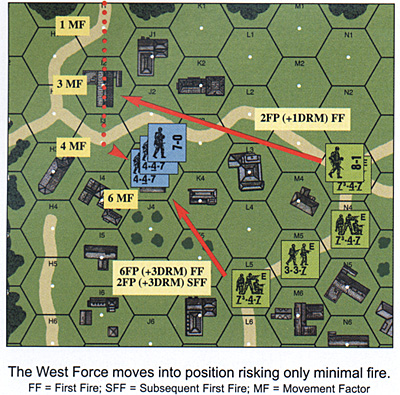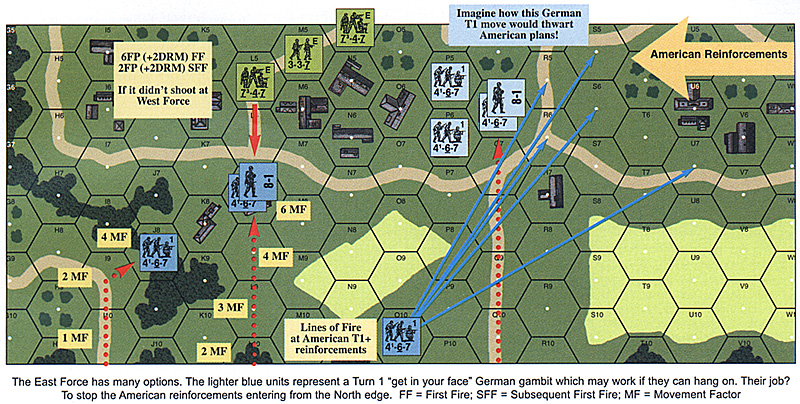 I had intended to write a general review of
the scenario S1 Retaking Vierville. I was at
least half way through writing the article when I
noticed that the scenario is already on ROAR.
The Remote Online Automated Record
(ROAR) is an on-line site where ASL players
can post scenario results. It accumulates
statistics on scenario win:loss records and
enjoyability.
I had intended to write a general review of
the scenario S1 Retaking Vierville. I was at
least half way through writing the article when I
noticed that the scenario is already on ROAR.
The Remote Online Automated Record
(ROAR) is an on-line site where ASL players
can post scenario results. It accumulates
statistics on scenario win:loss records and
enjoyability.
Retaking Vierville has a German: American won:loss record of 5:18. Wow. This caught me off guard, as I would gladly take either side in this scenario. So now instead of a general article I am writing about how to play the Germans in Retaking Vierville.
This article is not intended to tell you the one, single way to play the scenario or how to assure a win as the Germans. That's impossible to do in a game with so many decisions and dice rolls. I merely intend to point out a few things to help you take advantage of some opportunities that may, with some luck, come to the Germans.
S1 Retaking Vierville
It's the day after D-Day. On the Cotentin Peninsula the paratroopers of the 101st Airborne Division have begun collecting into cohesive fighting units. They begin leaving the town of Vierville to head on up the road and attack another German strongpoint. The Germans, however, decide that now's a good time to counterattack and select Vierville as the place to do it. They throw whatever scattered units they can into the attack on the town, from every direction.
The Americans, knowing that Vierville is important as a supply route, throw more and more paratroopers into the fray. So you've got a situation where both sides start out weak and gain strength as the day progresses. Eventually, American firepower and elan carry the day, and the Germans scatter back into the countryside to hide among the hedgerows, causing more problems for the Americans later on.
This sounds like a pretty cool action to recreate, and it is. (Thanks to John D. Johnson for the scenario design.) There is a lot of maneuver for such a small scenario, and the buildup of force is interesting. You never think you've got enough units, even after you get a few more next turn. And since there were no support units involved, the action fits perfectly into the ASLSK scheme of infantry- only fights.
The first thing the German player has to know and understand is the victory conditions of the scenario. The first few words are key: "The Americans win...." The American player will drive the pace of the game. That phrase generally means the defender, the Germans, has to hold some key piece of terrain or prevent the attacker from exiting or something similar. Which means that you've got to play it smart. Don't take a shot if you can accomplish the same thing by hiding instead. Don't put yourself in position to be shot at if you don't have to; hide instead . All you want to do is make sure you have units left at game end in the right place.
In this case, the American player wins if there are no Good Order German units in any of four building hexes: N5, N6, M4, and L3. Let's look at these buildings. They are all stone, so they're great defensive terrain (+3 dice roll modifier, DRM). All four buildings are unoccupied at the start of the game so it may be easy for the Americans to grab some. The Germans have to grab at least one building. So our focus will be on grabbing and holding at least one building.
Why emphasize "at least"? Because you shouldn't put all your eggs in one basket, that's why. If you can get and hold two by all means do so-this will force the American player to split up and attack two hexes. While you're both spreading your forces thin, either building will win you the game whereas the American player has to attack them both to try and break your units. If you're holding all four buildings after a few turns the American player is in such trouble that you can stop reading this article now.
Now, which buildings do we want to concentrate on taking and holding? The obvious (and proper) choice is buildings L3 and M4 as they are farthest away from the entry point of the American reinforcements. They support each other nicely.
If reinforcements can also grab N6, by all means go for it. That's pretty tough to do most of the time, but it really puts the pinch on the American player-especially late in the game when he is busy trying to break any units in building L3.
So what forces do the Germans have at hand? Well, none at start. On Turn 1 the Germans get 6 squads and two leaders. Unfortunately, on the one hand, they're split up. Fortunately, on the other hand, they're split up.
Say what?
Entering from both sides of the map does violate the principle of schwerepunkt-concentrating your force at one spot. However, it also puts you on both sides of the American force, which opens up your opportunities to hit them while moving on the roads. So, it's both good and bad.
 The West Force moves into position risking only minimal fire.
FF = First Fire; SFF = Subsequent First Fire; MF = Movement Factor
The West Force moves into position risking only minimal fire.
FF = First Fire; SFF = Subsequent First Fire; MF = Movement Factor
West Force
The west force enters on Turn 1 and contains your worst troops: 2nd line 4-4-7s. Their 4-hex range is no better than the Americans, while their 4 firepower means that the American 7-4-7s will enter close combat against you at a 3-2 advantage. Their leader, the 7-0, serves one purpose in this scenario, to rally broken units as best he can. His movement bonus is handy on Turn 1, but after that he just rallies guys. But these 2nd line units have an important purpose. They are the only troops who enter on the west edge and some, if not all, of them need to get to building L3.
Pretend the American commander is very aggressive and puts his 8-1 leader with the 7-4-7 in hex N3. This makes hexes K1, L1, and L2 deathtraps-forget about using them. Can the 7-4-7 see to K3? J2? Yes and yes. So those two hexes are also deathtraps. J1 is a little better since a longrange shot would just be a 2FP (-3DRM) shot, but that's still a 1 MC on an average dice roll! Forget about it. And don't be duped by a line of sight that looks blocked, that darned para squad and Sgt. Rock can see H2 as well, so a jaunt down the road is out of the question. Of course, the 7-4-7 would only get one shot at a range of more than 4 hexes, so the Germans may wish to try to bait him into shooting. But 1/3 of their force (a 4-4-7; do not use the 7-0 as bait) is a pretty expensive gambit.
This leaves one good path, with minimal risk, for the Germans entering the map. 11 (1 MF), 12 (3 MF), 13 (4 MF), and J3 (6 MF). You may get shot at 12 from N3 with a 2FP (+lDRM) attack (7 FP divided by 2 for Long Range; -1 leader, -1 FFNAM, +3 stone building). You may also get attacked in J3 from a 7-4-7 in L5 with full FP; but with +1 orchard, -1 FFNAM, and +3 building DRM you'll be facing a UP (+3DRM) attack, which has exactly the same results as the 2FP (+1 DRM) shot. Wince a bit and hope for an average dice roll.
Once in J3 you'll have a return shot in the Advancing Fire Phase of 4FP (+1 DRM) at the unit in L5. Payback's a ... well, you know. Hope for a nice low dice roll to mess up the American's day. Then advance a unit to K4.
I would send the 7-0 and two of the 4-4-7s on that jaunt into J3, moving just one 4-4-7 into K4 and leaving the other 4-4-7 and 7-0 in J3. Remember, split up to stay alive.
What about the other 4-4-7? You can enter anywhere on the west edge (between the A through V hexrows, that is). Wouldn't a 4-4-7 in U3 or P1 be a nut for the Americans to worry about? In U3 he'd have good shots to S5/R5/R6. Even S6 would only be hindered by the one orchard. A squad in U3 would stall the American advance south considerably. In P1 he'd hit S5, S6, T6, or T7 with a 2FP shot that would make the Americans at least think a bit before running down the road. And if they move through the grain you win the gambitthey've been slowed down considerably.
The life expectancy of these Iron Cross winners should be about 2 minutes, I'd say-in ASL terms that is. But if they buy even a single turn isn't that a plus for the Germans? And if they break but are left alone, a timely self rally could be a real death knell for the Americans. The more I think about it, the more I like it.
East Force

The east force consists of the good guys, the three 4-6-7s and the 8-1 leader. 8-1s are darned useful, they help fire attacks, close combat attacks, morale checks, and rally attempts. So losing one hurts. The 4-6-7s are great units in this scenario because they can fire out to 12 hexes. That's handy to have when you're trying to interdict the road from L6 out to R6 and beyond, if possible.
The same "enter along the entire side" concept applies along the eastern edge, so getting a guy into 010 may be a good idea. Such a unit could fire at S5 with 2 FP, lay 1 FP of residual, and still Subsequent First Fire into S6 or R6 with 2 FP laying another 1 FP of residual. This may slow down the American paratroopers a great deal, or at least make them mighty nervous. I don't think I'd commit two 4-6- 7s to this task, but one would be worthwhile. If he breaks, he can rout to N 10 and be out of the line of fire while in rally terrain. A 46-7 can move to J8 by itself to also get a 2FP (+ODRM) shot on the at-start American forces.
If you're feeling sassy do this after an aggressive Turn 1 move using the 8-1 and a 4-6-7 to move to L10 (2 MF), L9 (3MF), L8 (4MF), and L7 (6MF) where you would then receive a 6FP (+2DRM) or 2FP (+2DRM) attack. If you survive unscathed then you get to Advancing Fire back with the excellent 2FP (-1DRM) shot, and the Americans won't be able to shoot at the unit moving in J8 guarenteeing you that 2FP (+ODRM) shot. Don't get too aggressive with the 4-6-7s, however. They are needed to slow down the reinforcing Americans.
The East Force has many options. The lighter blue units represent a Turn 1 "get in your face" German gambit which may work if they can hang on. Their job? To stop the American reinforcements entering from the North edge. FF = First Fire; SFF = Subsequent First Fire; MF = Movement Factor
An ultra-aggressive move on Turn 1 would be to take most of the 4-6-7 force and move it Q10, Q9, Q8, Q7, and Q6 for 6MF. You could then break this knot up by putting a 4-6-7 in P5 and P6, leaving the 8-1 and 4-6-7 in Q6. This would be a huge knot in the face of the reinforcements. These guys will also all die. They have no rout paths to speak of, and an American player would probably move his at-start forces towards them, squeezing this force between the at-start units and the Turn 1 reinforcements. This would, however, give you time to get into the VP buildings without much of a fight. I haven't seen this work yet, but it is a very interesting move!
After the American Turn 1 the German player is likely to see some 7-4-7s in M4, M6 and N5. Hopefully, our "skirmishers" on the flanks have slowed down the American Turn 1 8-1 and 7-4-7s who will be out of the action this turn. Do not be tempted into advancing a Turn 14-6-7 into M7. You could score an 8FP (+3DRM) shot against an American squad in M6, but if miss you are in for a world of hurt with that return fire 12FP (+ODRM).
On Turn 2 you get the best German force, a stellar 9-1 leader and three 5-4-8 squads. The 5-4-8s are the backbone of your force because 8 morale troops in stone buildings is a darned fine combination for shrugging off fire attacks. Heck, on a 1 MC they pin on an average result-you can't beat that. When broken, they rally on a 9 or 10 in a building (if no longer desperate), depending on which leader they're stacked with.
Where do you bring on the excellent 5-4-8s? I like to run them, American LOS permitting, 110 (1MF), 19 (2MF), 18 (4MF), 17 (5MF), J6 (6MF) with intentions of advancing into K6 and/or J5, again depending on American dispositions. I like to see these guys around the mid I/J/K area on Turns 2 and 3.
One key ASL tactic that the German player has to take advantage of is assault moving out of line of sight (minimizing shots during the Defensive Fire Phase) and then using the Advance Phase to move back into the same position (assuming it's a good position) to be ready to interdict enemy movement. This may be the most controversial thing you'll execute in your early ASL career. Grognards call it "skulking." Some people think its "unrealistic" or "gamey."
Others say it perfectly represents hiding, getting out of the line of fire, etc., and that while you're skulking you're not doing anything else. I have zero problems with this tactic because ASL is a game, and this is just using the rules of the game. I agree that it can represent hiding but, more importantly, it prevents that unit from doing much of anything else. So you are almost being penalized for using this tactic in that for a half-turn that unit can do essentially nothing. Occasionally you want that. Sometimes you don't.
If you want to stop your opponent from skulking, put your troops in positions to shoot at the possible skulking locations. Remember, though, that sometimes not giving your opponent the choice of skulking means he may have nothing better to do than Prep Fire at you and ruin your day on a lucky dice roll. Is that really what you want?
In this scenario the Germans must skulk. Keep out of the American line of fire as long as possible. Your only goal here is to have a guy in L3 or M4 or N6 at the end of the scenario. Survival is best assured, in my opinion, by not being shot at. Words to live by, I say.
Anyway, use your Turn 3 guys much the same as you would your Turn 2 guys, circle around a bit and move into the victory building area by way of the back door. Just don't forget that someone will have to take L3 or M4 during these early turns to give you something to hold on to during the later turns. In closing, I'd like to say that I think a wily German player has a good chance in this scenario. Keep the American reinforcements at a distance as long as possible. Keep out of sight during the American Defensive Fire Phase as much as possible.
The only way to get better at ASL is to play a lot, so look me up at a local tournament and challenge me to a game. If I have the time, I'm there for your challenge. I'll even take the Germans in Retaking Vierville.
[Editor's Note: This scenario went 5:9 in favor of the Americans at the ASLSK tourney at the World Boardgaming Championships.]
Back to Table of Contents -- Operations #46
Back to Operations List of Issues
Back to MagWeb Master List of Magazines
© Copyright 2004 by MultiMan Publishing, LLC.
This article appears in MagWeb.com (Magazine Web) on the Internet World Wide Web.
Other articles from military history and related magazines are available at http://www.magweb.com